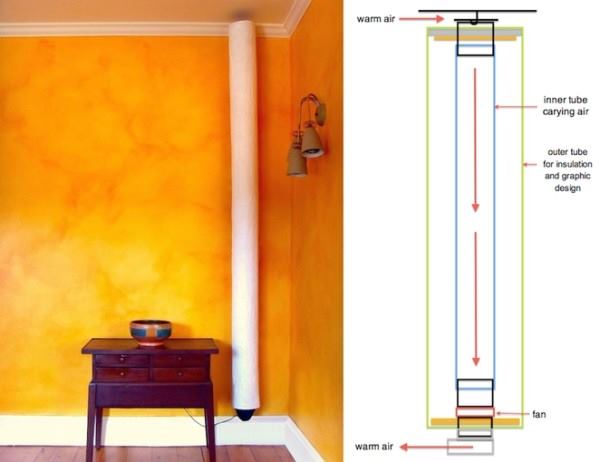High ceilings enhance the sense of openness in a space. However, concern around increased energy consumption is causing building owners to reconsider conditioning the entire volume of their interiors—a typical approach in the U.S. whereas in a country such as Japan, occupancy sensors are often used to direct heat. In older structures, for which a large interior temperature gradient is more common, high ceilings are still generally seen as positive architectural features. During the winter, however, the less-dense warm air in those spaces hovers closer to the ceiling than it does to occupants.
To address this problem, Portland, Maine–based inventor William Zelman developed Hot-Tubes, which he launched on Kickstarter last month to raise money for their fabrication and to generate market awareness for the product. The 32-day campaign ends on Oct. 10, but it has already surpassed its $10,000 goal. Each vertically-oriented, Tyvek-clad cylinder uses a fan at its base to pull warm air from the ceiling, through an internal tube, and down to the floor where it is re-circulated for occupant comfort. “Hot-Tubes work like a focused ceiling fan to bring heated air down to floor level, “ Zelman writes on his Kickstarter page. “That makes room temperatures more consistent (fewer cold spots) and reduces thermostat cycling. The bottom line is lower winter heating bills and a more comfortable winter home.”
Hot-Tubes measure 92 inches tall and 6 inches in diameter to accommodate ceiling heights of 8 feet to 11 feet while occupying minimal floor space. They also may be used as luminaires if LED light sources are integrated. Moreover, Zelman claims a 20-percent reduction in electricity and 10-percent reduction in natural-gas consumption based on the use of several Hot-Tubes during Maine’s bitterly cold 2014 winter as compared to the previous year.
Presumably, Hot Tubes far exceeded its Kickstarter funding goal due to high demand for such a simple, energy-efficient, and cost-effective method for winter heating. Still, the product’s design could benefit from becoming as aesthetically refined as it is thermally clever.
Blaine Brownell, AIA, is a regularly featured columnist whose stories appear on this website each week. His views and conclusions are not necessarily those of ARCHITECT magazine nor of the American Institute of Architects.
